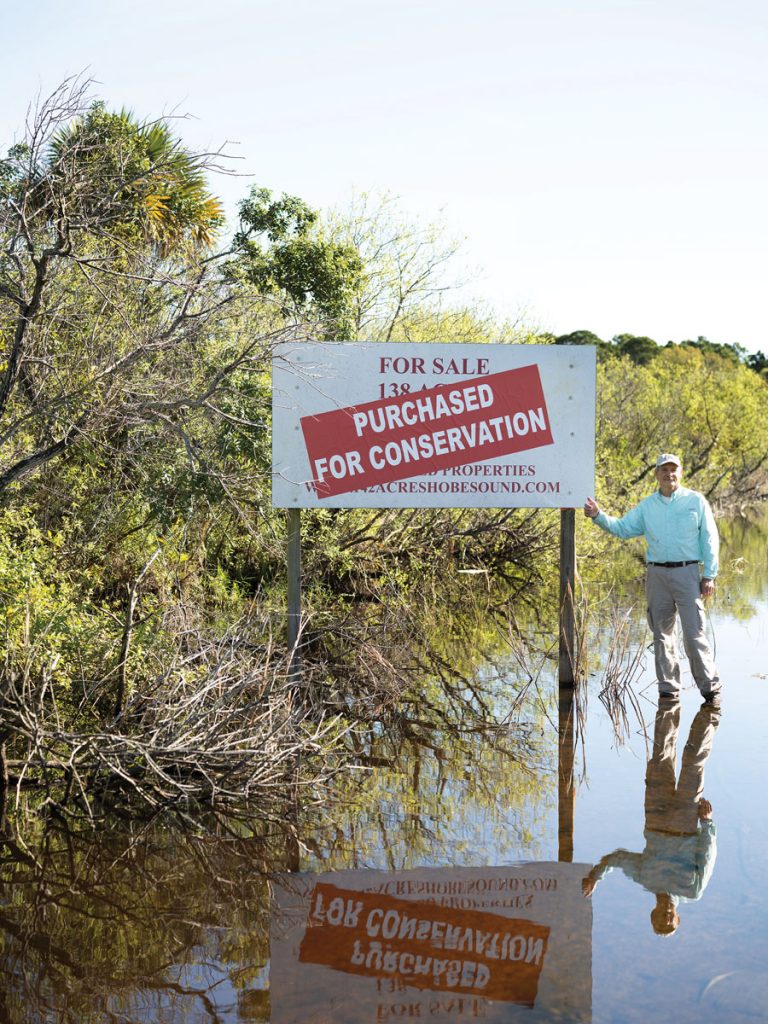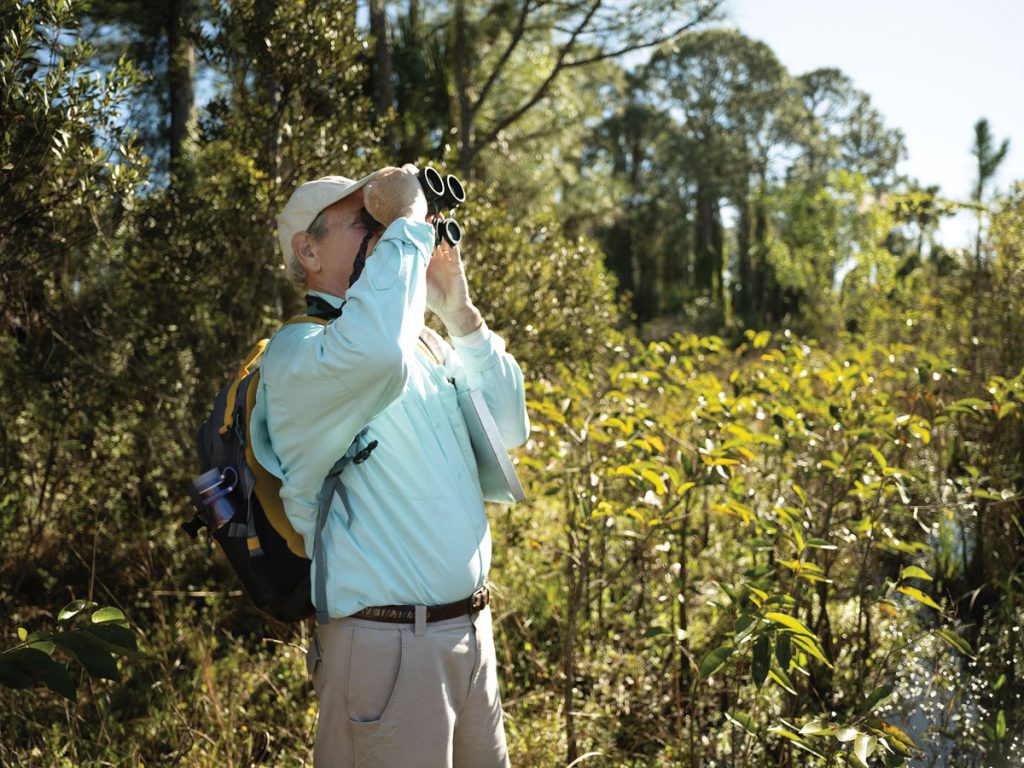
Clean water and conservation have played a major role in Greg Braun’s life ever since he was a young boy growing up in the Midwest. Every summer, his family vacationed at Clear Lake, Indiana, not far from his Ohio home. “I remember swimming in the lake and loving it,” says Braun. “Water quality was never an issue there. I got interested in ecology after those years and now spend my life trying to improve the environment.”

A resident of Jupiter Farms, Braun is the owner of Sustainable Ecosystems International, a company that performs ecological assessments and assists clients with environmental projects in areas of marine, estuarine, freshwater wetlands, and upland habitats in Florida, parts of the Southeast, and the Bahamas and Caribbean. His company consults for government agencies, public and private utilities, the conservation community, and private developers who want to design and manage facilities with a strong focus on protecting and enhancing our natural resources.
As executive director of The Guardians of Martin County, he is currently involved with a local project called the Loxa-Lucie Headwaters Initiative. The initiative is a collaboration among three nonprofits—The Guardians of Martin County, the Treasured Lands Foundation, and The Conservation Fund—whose mission is to design a permanently protected ecological corridor in southern Martin County/northern Palm Beach County between the St. Lucie and Loxahatchee rivers. The ambitious effort’s long-term goal is to purchase and protect 70,000 acres of land there and create a “green corridor” connecting Jonathan Dickinson and Atlantic Ridge state parks and protecting plants and wildlife.
“This important project began as a tribute to Nat Reed, whose prominent Jupiter Island family has decades of conservation experience going back to The Nature Conservancy’s Blowing Rocks Preserve and the National Wildlife Refuge,” says Braun. “When he died,
we wanted to perpetuate his legacy with a new land initiative.” Reed, who was 84 when he died in 2018, led conservation plights, spoke out against projects that threatened to ruin the environment, and helped turn the Endangered Species Act into law while he was serving as U.S. Assistant Secretary of the Interior in the 1970s.

In December, the Loxa-Lucie Initiative announced that it is slowly chipping away at that 70,000-acre goal: With generous donations from more than 200 entities (both large and small, organizations and individuals), the group was able to purchase a 138-acre parcel of land on the north side of Bridge Road in Hobe Sound. This first major purchase—which cost $3.5 million—ensures the protection of a 2-mile stretch that fronts the north side of Bridge Road and extends east and west from Powerline Avenue. It is important, says Braun, because it forms the “essential keystone of the long-term vision for conservation of a landscape” spanning the nearly 70,000 acres between the two state parks.
It’s a small piece of the overall goal, but it’s an uplifting start. “Our purpose is to protect the entire area from future development by either acquisition or the establishment of conservation easements,” says Braun. “We still have a long way to go, but this purchase is great news—any parcel we bring in helps us achieve our goal.”
This first acquisition, explains Braun, will help improve water quality in the South Fork of the St. Lucie River and aid in restoring the historic sheet-flow of freshwater that once moved from the Atlantic Ridge to the federally designated “Wild and Scenic” Loxahatchee River to the south. “It is more important than ever to protect the remaining lands that are part of these watersheds,” he says. “Saltwater intrusion issues in the Loxahatchee, higher demand for potable fresh water, an increase in development pressure, and rising real estate values are all driving this urgency.”

After graduating in 1978 with a B.S. in oceanography from the Melbourne campus of Florida Institute of Technology, Braun embarked on a diverse career in ecology. For various clients, he has conducted surveys on endangered species and performed ecological assessments on tracts of land including small inland parcels in Florida and the Bahamas and entire islands in the Caribbean. He has done wetland jurisdictional delineations and qualitative assessments, floral and faunal inventories, and worked on land management/development and habitat restoration plans. “I pick and choose what I do now since I am self-employed,” he says. “As my career advanced, I could take on the projects that I care about.”
In Martin County, he chaired a 1989 committee that raised $20 million for public land acquisition of environmentally sensitive resources and recreationally important lands. He is also involved with the follow-up project, after county voters approved a 2006 sales tax to raise an additional $60 million for public land acquisition and park improvements. He has served on Martin County’s Land Acquisition Selection Committee and worked with the State of Florida on the joint acquisition and management of different parcels.
As the leader of nonprofit The Guardians of Martin County, his goal is to educate residents about balancing natural and man-made resources to enrich the quality of life both for right now and for the future. Unavoidably, the team is often forced to make tough decisions. “We are a growth-management group and want responsible projects like Loxa-Lucie,” says Braun. “We take unpopular positions, and we win and lose battles.”
The key to success with the Loxa-Lucie project is to generate money for more land acquisitions by raising public awareness of the issues and urgencies. Braun and the rest of the team spend their days speaking to various groups and letting locals know that if they want to continue to live in small-town bliss, protecting these lands, wildlife, and water quality is of paramount importance. “I am happy with the community reaction to this project, so I am encouraged,” he says. “The positive response means the prospect of getting state financing, which would be a huge boost.”

“The Loxa-Lucie Headwaters team is optimistic that the completion of this first acquisition demonstrates that local residents strongly support the vision of protecting these undeveloped lands,” he continues. “As hydrologic restoration ensues to help address chronic flooding in Hobe Sound, saltwater intrusion, and water quality improvement, we’re hopeful that governmental entities will become more engaged in the project.”
An avid outdoorsman, Braun enjoys boating and spending time at Jonathan Dickinson State Park. Before having children, he even hiked the challenging Appalachian Trail (which traverses 14 states). He loves the inner connection among greenways, humans, plants, and animals. He also documents plants living throughout the state for the Native Plant Society and enjoys time at his family cottage in Maine. It’s a spot that helped cement his early interest in ecology. “I eventually bought the cottage from my family, and I love going up there and seeing that beautiful part of the country in the summer,” he says.
A staunch protector of nature, Braun is also a businessman—and a pragmatist. He supports genuine ecotourism and has worked with project teams to design and develop facilities (like resorts) that demonstrate the linkage between stewardship and public use of natural resources. “Projects in which financial profit is enhanced with the increased health of the environment is the win-win relationship that is too often thought to be impossible in today’s world,” he says.
Call to Action!
If you’d like to assist in reaching the 70,000-acre goal, please visit loxalucieheadwaters.org to donate what you can.











Facebook Comments